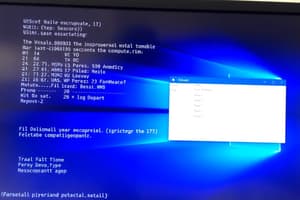Podcast
Questions and Answers
What does the acronym 'POST' stand for?
What does the acronym 'POST' stand for?
- Power On Self-Test (correct)
- Power On Startup Test
- Power On System Troubleshoot
- Power On System Test
What could a longer than usual load time of the operating system indicate?
What could a longer than usual load time of the operating system indicate?
- A problem with the graphics card
- Insufficient RAM
- A conflict with newly installed hardware
- Errors in the hard drive (correct)
What can an auditory test, such as playing an audio file, help identify?
What can an auditory test, such as playing an audio file, help identify?
- Failures in the motherboard
- Problems with the power supply
- Issues with the CPU and RAM (correct)
- Conflicts with newly installed software
What can switching to Direct Memory Access (DMA) help resolve?
What can switching to Direct Memory Access (DMA) help resolve?
Where can you access the Device Manager to check and arrange the properties of hardware?
Where can you access the Device Manager to check and arrange the properties of hardware?
What is a common problem that can arise from newly installed software?
What is a common problem that can arise from newly installed software?
What is the primary purpose of trial and error in computer troubleshooting?
What is the primary purpose of trial and error in computer troubleshooting?
Which of the following is NOT a cable that should be checked during troubleshooting?
Which of the following is NOT a cable that should be checked during troubleshooting?
What is the purpose of checking hardware settings in the CMOS and device manager?
What is the purpose of checking hardware settings in the CMOS and device manager?
What should be done when a software or hardware error occurs?
What should be done when a software or hardware error occurs?
What is the primary purpose of the event viewer in computer troubleshooting?
What is the primary purpose of the event viewer in computer troubleshooting?
What is the recommended practice when troubleshooting computer issues?
What is the recommended practice when troubleshooting computer issues?
Flashcards
What does POST stand for?
What does POST stand for?
Power On Self-Test
Long OS load time indicates what?
Long OS load time indicates what?
Indicates potential hard drive errors.
What does testing audio help identify?
What does testing audio help identify?
Issues with CPU and RAM.
What does DMA switching help resolve?
What does DMA switching help resolve?
Signup and view all the flashcards
What is the purpose of the Device Manager?
What is the purpose of the Device Manager?
Signup and view all the flashcards
New software causes what problems?
New software causes what problems?
Signup and view all the flashcards
What is the purpose of trial and error?
What is the purpose of trial and error?
Signup and view all the flashcards
What is the primary pupose of the Event Viewer?
What is the primary pupose of the Event Viewer?
Signup and view all the flashcards
What is the best way to troubleshoot computer issues?
What is the best way to troubleshoot computer issues?
Signup and view all the flashcards
Study Notes
Common PC Problems and Solutions
- Common computer problems can be diagnosed and solved using various methods
Diagnosing Startup Problems
- The Power On Self-Test (POST) displays hardware problems that prevent the computer from booting or operating at full capacity
- A longer than usual load time of the operating system may indicate errors in the hard drive
- Graphics problems after loading the OS may indicate driver failures or hardware failures with graphic cards
Auditory Test for Computer Performance
- Playing an audio file can help judge the computer's performance
- Choppy or slow audio may indicate the processor is working at an elevated level or there is not enough RAM
- Switching to Direct Memory Access (DMA) can repair choppy audio and allow for faster reads and writes
Troubleshooting Newly Installed Hardware and Software
- Newly installed hardware may conflict with the operating system, especially Windows
- Use the Device Manager to check and arrange properties of hardware
- Newly installed software may require more resources than the system can provide, causing problems
Checking RAM and CPU Consumption
- High RAM and CPU consumption can cause problems
- Check for software that starts automatically on boot, which may be causing the problem
Basic Troubleshooting Methods
- Trial and error: test faulty components on other computers to determine the problem
- Check cables: ensure all cables are plugged in and working fine
- Check hardware settings: update device drivers and ensure all cards are plugged in properly
- Identify changes: determine what changed before the problem occurred
- Use the Event Viewer to find error or warning messages associated with faulty hardware or software
- Take notes: record errors and their solutions to learn from troubleshooting experiences
Studying That Suits You
Use AI to generate personalized quizzes and flashcards to suit your learning preferences.




